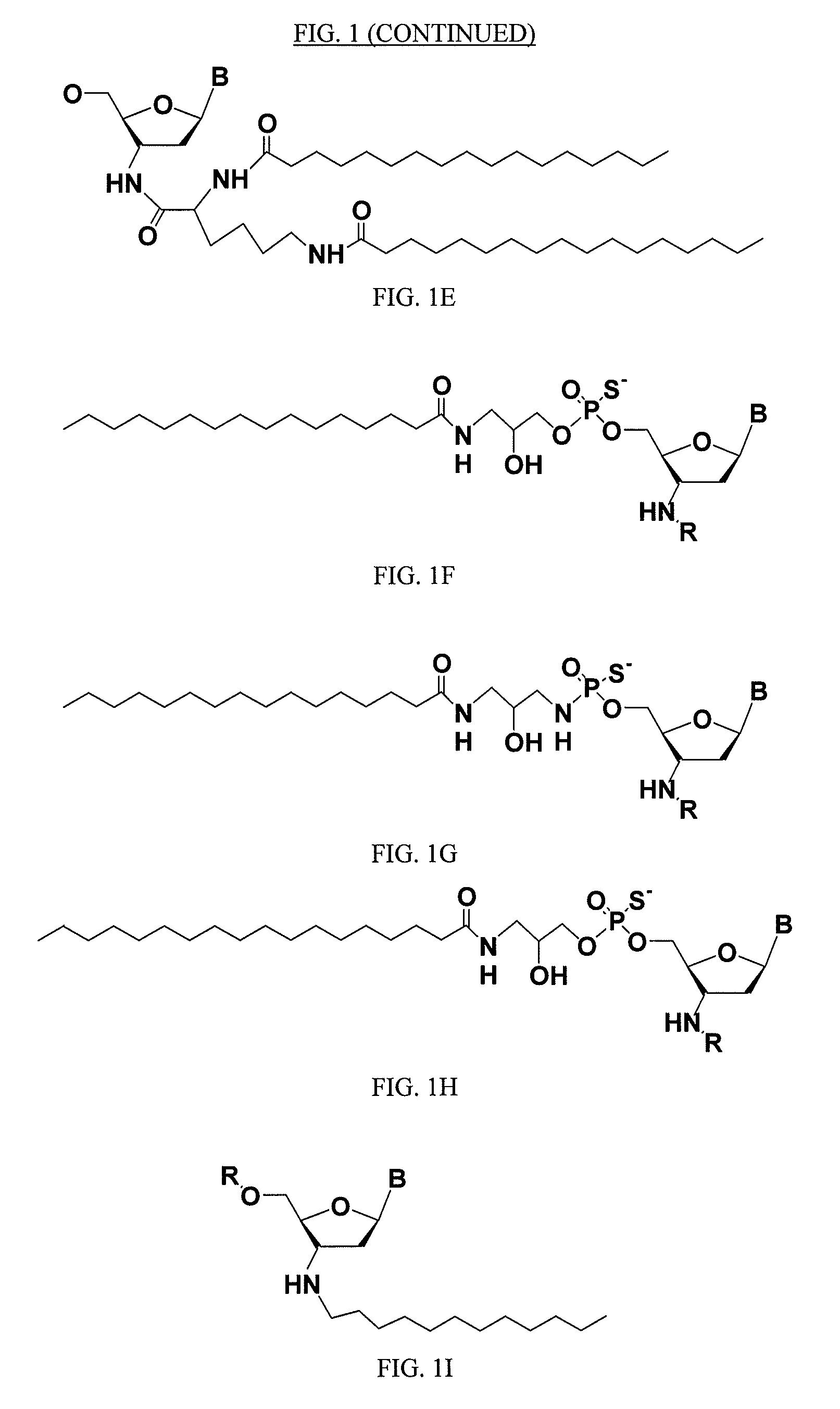Modified oligonucleotides for telomerase inhibition
a technology of telomerase and oligonucleotides, applied in the field of compounds, can solve the problems of limiting the efficiency of cellular uptake, reducing the stability of duplexes, and cellular uptake, and achieves the effects of reducing toxicity risks, superior cellular uptake properties, and cost saving
- Summary
- Abstract
- Description
- Claims
- Application Information
AI Technical Summary
Benefits of technology
Problems solved by technology
Method used
Image
Examples
example 1
Synthesis of Compounds
A. General Methods
[0183]Oligonucleotide N3′→P5′ phosphoramidates (NP) and thiophosphoramidates (NPS) were synthesized on a 1 μmole scale using the amidite transfer reaction on an ABI 394 synthesizer according to the procedures described by McCurdy et al., (1997) Tetrahedron Letters, 38:207-210 and Pongracz & Gryaznov, (1999) Tetrahedron Letters 49:7661-7664, respectively. The fully protected monomer building blocks were 3′-aminotrityl-nucleoside-5′-(2-cyanoethyl-N,N-diisopropylamino)nucleosidephosphoramidites, specifically 3′-deoxy-thymidine, 2′, 3′-dideoxy-N2-isobutyryl-guanosine, 2′, 3′-dideoxy-N6-benzoyl-adenosine,and 2′, 3′-dideoxy-N4-benzoyl-cytidine purchased from Transgenomic, Inc. (Omaha, Nebraska). 3′-aminotrityl-5′-succinyl-nucleosides were coupled with amino group containing long chain controlled pore glass (LCAA-CPG) and used as the solid support. The synthesis was performed in the 5′ to 3′ direction. Oligonucleotides with NP backbones were synthesi...
example 2
Activity of Compounds in Biochemical and Cell-Based Assays
[0204]Conjugated oligonucleotides as described herein were tested for their ability to inhibit telomerase in the biochemical Flashplate assay and the cell-based assay, as described above and in Asai et al. (2003). The results are presented in the following table. In this table, the following abbreviations are used:
[0205]Oligonucleotide Sequences:
[0206]1=TAGGGTTAGACAA, complementary to bases 42-54 of hTR, SEQ ID NO:1
[0207]2=CAGTTAGGGTTAG, complementary to bases 38-50 of hTR, SEQ ID NO:1
[0208]Chemistry:
[0209]NP indicates that the oligonucleotide has phosphoramidate internucleoside linkages
[0210]NPS indicates that the oligonucleotide has thiophosphoramidate internucleoside linkages
[0211]Conjugate:
[0212]5′ indicates that the lipid moiety is conjugated to the 5′ terminus of the oligonucleotide
[0213]3′ indicates that the lipid moiety is conjugated to the 3′ terminus of the oligonucleotide
[0214]Human Cancer Cell Types (all Available...
example 3
Comparative Potency and Bioavailability Studies
[0223]Two compounds of the invention, along with a non-conjugated oligonucleotide, were selected for separate detailed studies. The selected compounds, depicted in FIG. 9, were as follows:
[0224]Compound A (non-conjugated): a thiophosphoramidate oligonucleotide of sequence TAGGGTTAGACAA (this sequence is complementary to bases 42-54 of hTR, SEQ ID NO:1) (FIG. 9A).
[0225]Compound B: the oligonucleotide of compound A conjugated to 3′ palmitoylamide (FIG. 9B).
[0226]Compound C: the oligonucleotide of compound A conjugated to 5′-palmitoylamido-glycerol-thiophosphate (FIG. 9C). Studies on these compounds are reported in this and the following Examples.
[0227]The following table shows the melting temperatures of each of these three compounds when associated with matched RNA (determined using standard methods), the IC50 value for telomerase inhibition determined using the biochemical assay, and the IC50 for telomerase inhibition determined using t...
PUM
| Property | Measurement | Unit |
|---|---|---|
| flow rate | aaaaa | aaaaa |
| melting temperature | aaaaa | aaaaa |
| structure | aaaaa | aaaaa |
Abstract
Description
Claims
Application Information
 Login to View More
Login to View More - R&D
- Intellectual Property
- Life Sciences
- Materials
- Tech Scout
- Unparalleled Data Quality
- Higher Quality Content
- 60% Fewer Hallucinations
Browse by: Latest US Patents, China's latest patents, Technical Efficacy Thesaurus, Application Domain, Technology Topic, Popular Technical Reports.
© 2025 PatSnap. All rights reserved.Legal|Privacy policy|Modern Slavery Act Transparency Statement|Sitemap|About US| Contact US: help@patsnap.com



